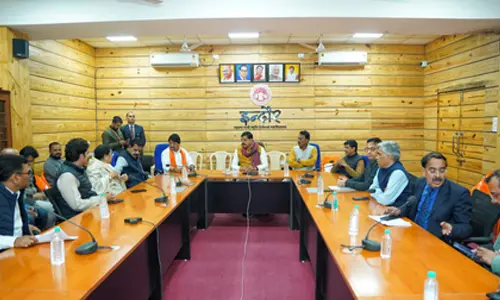Vigyan Samagam showcases country's mega-science projects

India is a proud participant in several prestigious international mega-science projects.
New Delhi: India is a proud participant in several prestigious international mega-science projects. To showcase India's vital contribution to these frontline scientific research endeavors and to generate keen interest in science among general public, Department of Atomic Energy (DAE) and Department of Science & Technology (DST), along with National Council of Science Museums (NCSM), have embarked upon a first of its kind ambitious public outreach programme in India for popularising science Vigyan Samagam.
This unique multi-venue mega-science exhibition has been conceived and organized with an aim to providing a common interactive platform for industry, academia and institutions. Also, the initiative takes a unique route to promote awareness on science in the public sphere, with emphasis on engaging young students and to ignite in them deep curiosity and inclination for science.
Cutting-edge mega science & technology
India is among a select few nations that actively collaborate on various mega-scale international projects on fundamental science and research that aims at advancing human knowledge by leaps and bounds. The exhibition celebrates India's participation as one of the core contributors in seven international collaborative mega-science projects, namely, European Organization for Nuclear Research (CERN), International Thermonuclear Experimental Reactor (ITER), Facility for Antiproton and Ion Research (FAIR), India-based Neutrino Observatory (INO), Laser Interferometer Gravitational-Wave Observatory (LIGO), Thirty Meter Telescope (TMT) and Square Kilometer Array (SKA).
To know "the origin and fundamental nature of the universe" and to answer the question like 'What is the universe ultimately made of and how it has evolved?" international science projects like CERN and FAIR are carrying out research in high-energy nuclear physics to reveal the contents of the heart of matter.
The aim is to search for "fundamental" particles the building blocks of the universe by accelerating tiniest constituents of matter in a circular path and smashing them in mega machines called particle accelerators at nearly the speed of light. In 2012, the A Toroidal LHC ApparatuS (ATLAS) and Compact Muon Solenoid (CMS) experiments at the Large Hadron Collider (LHC) of CERN made the first-ever observation of Higgs boson, also popularly called the 'God Particle'. Notably, bosons are particles that follow Bose–Einstein statistics and are named after Indian physicist Satyendra Nath Bose.
The US-based LIGO Laboratory made a series of gravitational wave detection beginning from 2015, validating the prediction of gravitational waves made on the basis of Albert Einstein's theory of general relativity nearly a hundred years ago.
The SKA project is an international effort to build the world's largest radio telescope to peer deep into the universe, aiming to reveal mysteries of the "Big Bang", the genesis of the universe and its evolution through time. For this, thousands of dishes and more than a million antennas are being set up across distances spanning thousands of kilometers.
The TMT project is building the world's largest ground-based optical telescope. Unlike a radio telescope, the mega optical telescope will see the universe in the "visible" light spectrum just like a human eye but with millions of times greater light-gathering capacity than that of a human eye.
About 100 trillion neutrinos pass through each of us every second! Yes, unbelievable but true! Neutrinos travel at the speed of light and pass through matter unhindered.
Since they hardly ever interact with matter, neutrinos are extremely difficult to detect. The INO (India-based Neutrino Observatory) is being built deep beneath a mountaintop, with an aim to detect these elusive charge-neutral particles.
The ITER is a huge international collaborative project focused on the goal of advancing the science and technology related to nuclear fusion, to make this virtually inexhaustible and clean power-generation option commercially practical.
India, along with other collaborating countries, makes vital contributions to all of these International mega-science projects through funding and 'in kind' contributions by developing, manufacturing, testing and supplying state of the art equipment, software and support.
Vigyan Samagam brings under spotlight these prestigious global research projects and India's vital contribution to them. On display at all the venues will be exhibits from CERN as well as the other six mega-science projects.
The CERN exhibit is the star attraction and a special treat for visitors. There is also a separate gallery/stall depicting India's contribution to CERN.
A multi-venue mega show
Launched in Mumbai as the first venue on May 8, 2019, Vigyan Samagam will be organised in four cities in India over the course of almost 11 months in Mumbai (Nehru Science Centre), Bengaluru (Visvesvaraya Industrial & Technological Museum), Kolkata (Science City, East Topsia) and Delhi (The National Science Cenre). The exhibition will be hosted for a period of 8 weeks at each of these four venues. There would be a period of 2 to 4 weeks during which the exhibition would be relocated to the next city. The multi-venue exhibition is being organised from May 2019 to March 2020.
Truly, Vigyan Samagam is a mega opportunities for everyone to get an amazing peek into the world of cutting-edge mega science.














